As pink sky slowly darkens behind tall trees, six scientists stand motionless outside the veterinary clinic at Northwest Trek. Only a robin’s chirp pierces the cool air. All eyes are fixed on the clinic’s overhang roof, straining to see through the shadows.
They’re waiting for the appearance of a tiny creature that’s often misunderstood, yet is vital to human health, and is now in danger from a deadly disease.
They’re waiting for bats.
6:00 p.m.
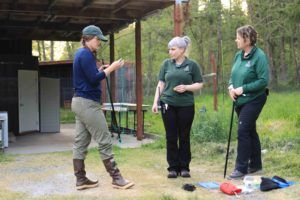
Scientists Michelle Tirhi and Abby Tobin arrive at Northwest Trek, and start scouting bat roosts with Trek staff: conservation engagement coordinator Rachael Mueller, veterinary technician Sara Dunleavy and staff biologist Wendi Mello, along with Mueller’s counterpart Zachary Hawn from sister zoo Point Defiance Zoo & Aquarium. Tirhi and Tobin are wildlife biologists with the Washington Department of Fish and Wildlife, and they’re here for three reasons.
The first reason is that the park has an awful lot of wild bats: at least three large colonies roosting under the eaves of different buildings, plus more in dedicated “bat boxes” scattered around the park. With 700-800 bats, Trek has possibly the second-largest colony in the South Sound. And being a wildlife park, the bats are both protected and accessible.
The second reason is that bats across the country have been devastated by a deadly fungal disease. White-nose syndrome, which affects the skin of bats’ noses, ears and wings and saps their energy reserves while they hibernate, has killed over six million bats in eastern North America since it was first discovered in 2006, entirely wiping out some colonies. This is a problem, since bats not only eat insects that threaten human health and crops (they can devour over a thousand per hour), they’re also huge pollinators in some areas.
And the third reason is that white-nose syndrome, first discovered in King County in 2016, has just been found in Pierce County – in Eatonville, just seven miles down the road. Which suddenly makes studying the bats at Northwest Trek even more important.
7:00 p.m.
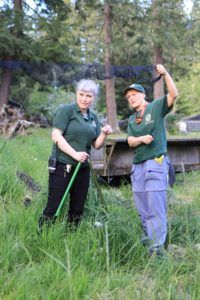
After assessing the other roost locations, Tirhi and Tobin choose the vet clinic as the best place to set up. Unlike previous studies at Trek, which have focused on counting bats and collecting their guano (poop) for lab analysis, tonight the scientists will be gently catching live bats to ID species and swab them to test for white-nose syndrome. Along the way they’ll assess their overall health, which will add to the pool of knowledge about this disease.
“White-nose syndrome is not harmful to humans, pets or livestock,” explains Mueller, as the others start unpacking. “But it’s deadly to bats, and there’s no cure. We know about how it affects bats on the east coast, since they hibernate in big cave colonies. But Washington bats are more solitary, and hibernate in a variety of places, including deep in the mountains. That’s why Trek’s colonies are so valuable.”
All the scientists pitch in to set up mist nets: strips of fine mesh, almost transparent, that stretch between poles and are used by biologists to trap birds and bats without harming them. Hammering and staking poles, they stretch the nets around the covered outside area where, right now, the bats are still sleeping up in the eaves.
The plan is that at sunset as the bats fly out to hunt, some will fly into the nets where Tirhi and Tobin will be ready to gently gather them up to be studied – with leather gloves, of course. (Bats can carry rabies, and while all the scientists have had inoculations, it’s still best to avoid bites.)
7:15 p.m.
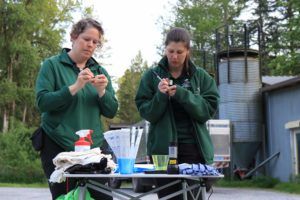
At the swabbing table, Tobin sets out tiny scales, calipers, swab packets, wipes and a thin digital lightbox. Tiny tubes await swab tips, and there are flashlights, one with UV (the white-nose fungus fluoresces into orange under that spectrum).
“We’ll be swabbing over their muzzle and wings,” she says, “then sending the samples to the Oregon Veterinary Diagnostic Laboratory for testing.”
What’s cool about this kind of science, however, is that non-scientists can help too. The WDFW encourages people to let them know about sick or dead bats in their area, or groups of bats, and it was in fact from one of these citizen reports that the syndrome was first confirmed in Pierce County.
8:20 p.m.
It’s sunset, and the group assembles around Tobin for last-minute instructions, attaching headlamps. Tobin and Mueller disappear around the back of the building, while Tirhi hunkers down near the nets. The sky turns pink behind the trees, and a robin chirps noisily – it also has a nest under the eaves.
Zach Hawn positions himself with an echometer device, which records the sounds bats make to find prey. Inaudible to human ears, they can be analyzed to determine species.
8:44 p.m.
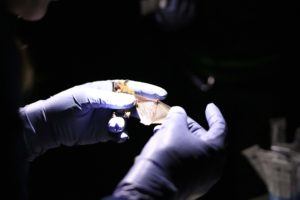
The shadows deepen. Mosquitoes appear – a choice dinner for bats.
Around the back, four bats have flown out and into the nets. Tobin and Tirhi gently extricate them and enclose them in soft cotton bags for Mueller to take around and lay on a heating pad. Around a dozen more, however, have flown right over the nets into the night.
Everyone else waits, staring into the darkness.
8:55 p.m.
Even the robin has given up, and the silence is complete. Tirhi checks the nets – no bats.
“Well,” she says. “This is bats for you. They’re wild animals. Let’s just look at the four we have.”
9:00 p.m.
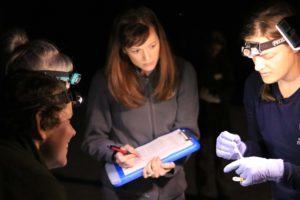
Tobin gently lowers a bag onto the scale, then ever-so-carefully reaches in to scoop out a bat. It’s tiny, about the size of a baby bird, all elbows and joints as it squirms in her hand, chirruping. With expert fingers she stretches out one wing then another, holding them over the lightbox to check for injuries or scars. They’re paper-thin, with strong, tiny bones. Bats are the only mammals that can truly fly, and up close this anatomy is nothing short of astonishing. Tobin runs a swab over its nose and wing, then pops the swab tip in a tube.
Next, she checks the sex – a female – and measures its forearm, one way of determining species. (Another is to check on the type of calcar, or heel bone.) It’s a Yuma myotis, one of the most common species here. Everyone switches off their headlight and she runs the pink UV over the bat’s little body. Its long teeth gleam white.
You can almost feel the relief when nothing shows up orange.
Finally, Tobin dots the bat’s forehead with blue marker, just in case it’s ever caught again (little brown bats can live up to 30 years in the wild) and walks away from the light to release it. As she lifts up her hands, the tiny creature climbs out of her fingers, like a cross between a goblin and a tiny dragon.
“Ohhh!” exclaims everyone.
Then the bat orients itself and darts off into the night like a shadow.
9:30 p.m.
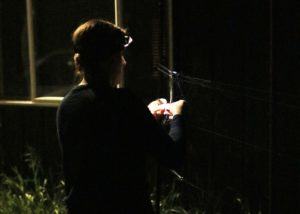
After the other three bats are sampled and released, the team gathers to discuss next moves. The WDFW requires a minimum of 25 samples for a reliable study, but there’s no guarantee that another night with nets would achieve that.
Instead, Mueller’s going to swab roosting bats during the day – easy to do without disturbing them – and collect more guano to fill out the study.
Tirhi starts dismantling the nets. Tobin begins wiping and packing equipment.
Out in the forest, Northwest Trek’s bats are hunting, gobbling up insects and making the world a happier place for humans.
And in return, the humans are racing the clock to understand and protect them.
HOW YOU CAN HELP
- If you see a sick or dead bat, or a group of bats, tell the Washington Department of Fish and Wildlife at 360-902-2515 or wdfw.wa.gov/bats.
- Never handle a live bat with your bare hands.
- Avoid entering areas where bats may live to limit spreading the fungus that causes white-nose syndrome, and disturbing roosting bats. If you come into contact with crevices, talus areas, caves or mines, clean your gear. (Visit whitenosesyndrome.org to find out how.)
- Do not allow pets to access areas where bats may roost or hibernate – they may carry the fungus to new sites.
- Improve bat habitats by reducing lighting around your home, minimize tree clearing and protect streams and wetlands. Try to incorporate snags into your landscape – this offers habitat for bats and other wildlife.
LEARN MORE: Here on our bat page.